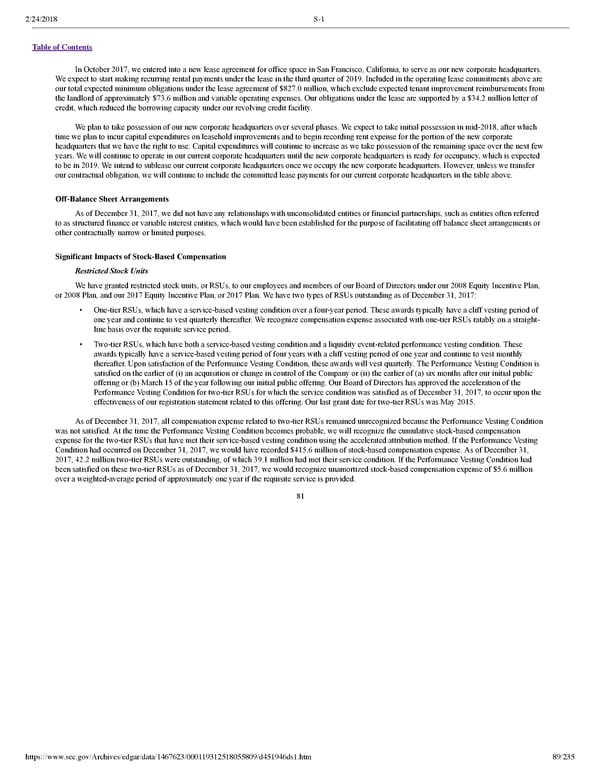2/24/2018 S-1 Table of Contents In October 2017, we entered into a new lease agreement for office space in San Francisco, California, to serve as our new corporate headquarters. We expect to start making recurring rental payments under the lease in the third quarter of 2019. Included in the operating lease commitments above are our total expected minimum obligations under the lease agreement of $827.0 million, which exclude expected tenant improvement reimbursements from the landlord of approximately $73.6 million and variable operating expenses. Our obligations under the lease are supported by a $34.2 million letter of credit, which reduced the borrowing capacity under our revolving credit facility. We plan to take possession of our new corporate headquarters over several phases. We expect to take initial possession in mid2018, after which time we plan to incur capital expenditures on leasehold improvements and to begin recording rent expense for the portion of the new corporate headquarters that we have the right to use. Capital expenditures will continue to increase as we take possession of the remaining space over the next few years. We will continue to operate in our current corporate headquarters until the new corporate headquarters is ready for occupancy, which is expected to be in 2019. We intend to sublease our current corporate headquarters once we occupy the new corporate headquarters. However, unless we transfer our contractual obligation, we will continue to include the committed lease payments for our current corporate headquarters in the table above. OffBalance Sheet Arrangements As of December 31, 2017, we did not have any relationships with unconsolidated entities or financial partnerships, such as entities often referred to as structured finance or variable interest entities, which would have been established for the purpose of facilitating off balance sheet arrangements or other contractually narrow or limited purposes. Significant Impacts of StockBased Compensation Restricted Stock Units We have granted restricted stock units, or RSUs, to our employees and members of our Board of Directors under our 2008 Equity Incentive Plan, or 2008 Plan, and our 2017 Equity Incentive Plan, or 2017 Plan. We have two types of RSUs outstanding as of December 31, 2017: • Onetier RSUs, which have a servicebased vesting condition over a fouryear period. These awards typically have a cliff vesting period of one year and continue to vest quarterly thereafter. We recognize compensation expense associated with onetier RSUs ratably on a straight line basis over the requisite service period. • Twotier RSUs, which have both a servicebased vesting condition and a liquidity eventrelated performance vesting condition. These awards typically have a servicebased vesting period of four years with a cliff vesting period of one year and continue to vest monthly thereafter. Upon satisfaction of the Performance Vesting Condition, these awards will vest quarterly. The Performance Vesting Condition is satisfied on the earlier of (i) an acquisition or change in control of the Company or (ii) the earlier of (a) six months after our initial public offering or (b) March 15 of the year following our initial public offering. Our Board of Directors has approved the acceleration of the Performance Vesting Condition for twotier RSUs for which the service condition was satisfied as of December 31, 2017, to occur upon the effectiveness of our registration statement related to this offering. Our last grant date for twotier RSUs was May 2015. As of December 31, 2017, all compensation expense related to twotier RSUs remained unrecognized because the Performance Vesting Condition was not satisfied. At the time the Performance Vesting Condition becomes probable, we will recognize the cumulative stockbased compensation expense for the twotier RSUs that have met their servicebased vesting condition using the accelerated attribution method. If the Performance Vesting Condition had occurred on December 31, 2017, we would have recorded $415.6 million of stockbased compensation expense. As of December 31, 2017, 42.2 million twotier RSUs were outstanding, of which 39.1 million had met their service condition. If the Performance Vesting Condition had been satisfied on these twotier RSUs as of December 31, 2017, we would recognize unamortized stockbased compensation expense of $5.6 million over a weightedaverage period of approximately one year if the requisite service is provided. 81 https://www.sec.gov/Archives/edgar/data/1467623/000119312518055809/d451946ds1.htm 89/235
 Dropbox S-1 | Interactive Prospectus Page 88 Page 90
Dropbox S-1 | Interactive Prospectus Page 88 Page 90